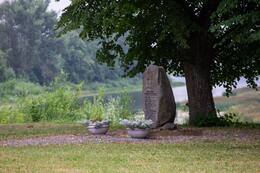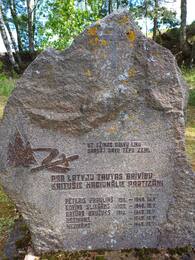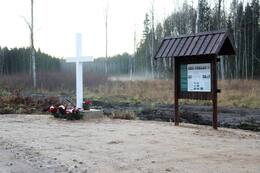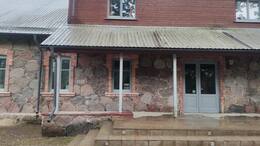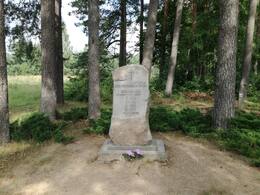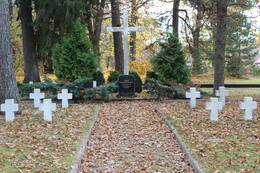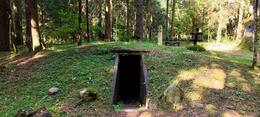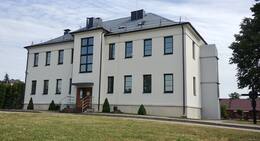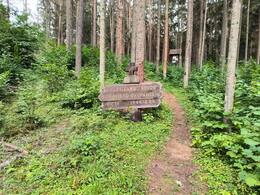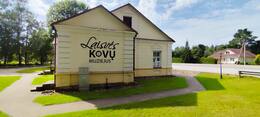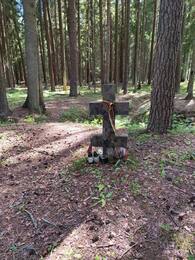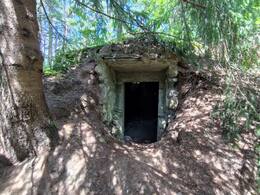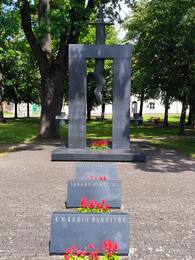Latvijos ir Lietuvos partizanų – miško brolių – kovų vietomis
Atminimo akmuo Rihardo Pārupo nacionalinei partizanų grupei
Įsikūręs Rygos gatvėje, netoli Krustpilio liuteronų bažnyčios.
1996 m. rugsėjo 22 d. Krustpilyje buvo atidengtas atminimo akmuo Rihardui Pārupui ir jo vadovaujamai nacionalinei partizanų grupei. Atminimo akmenį sukūrė skulptorius Ilgvaras Mozulānsas, o jo sukūrimą finansiškai parėmė Saeimos pirmininkė Ilga Kreituse. Šį renginį organizavo Latvijos nacionalinių partizanų asociacijos valdyba.
Rihardo Pārupo nacionaliniams partizanams,
kuriuos nužudė Čekos specialioji grupė
Richardas Parupsas (1914 m. – 1946 m. liepos 2 d.)
Grupės vadas
Richardas Stulpinsas (1923–1946 m. vasario 7 d.)
Alberts Avotiņš (1912 m. – 1946 m. liepos 2 d.)
Erikas Juhna (1928 m. – 1946 m. liepos 2 d.)
Aleksandrs Lācis (1919 m. – 1946 m. liepos 2 d.)
Petras Lokys (1921–1946 m. liepos 2 d.)
Jānis Ēvalds Zālītis (Āboliņš) (1911 – 1946 m., liepos 2 d.)
Zygfridas Bimšteinas, Teodoras Šmidtas (… – 1946 m. liepos 2 d.)
Uldis Šmits (... - 1946. 2. VII)
Peteris Lazdanas (1926–1947)
Erikas Konvalis (1929 – 1947. VI)
Niklāss Ošiņš (1908 m. – 1954 m. spalio 12 d.) – įvykdyta mirties bausmė Rygoje
Albertas Čiķauka (1911–1972 II) – kalėjo Mordovijos stovykloje
Rihardas Pārupsas gimė 1914 m. birželio 11 d. Krustpilio valsčiaus „Kaķīšiuose“. Antrojo pasaulinio karo metu jis buvo 15-osios Latvijos divizijos prieštankinės divizijos seržantas. Dalyvavo nacionalinėse partizanų operacijose Jekabpilio ir Maduonos apylinkėse, buvo Nacionalinio pasipriešinimo judėjimo narys, būrio Jekabpilio ir Maduonos apylinkėse vadas. Rihardas Pārupsas žuvo mūšyje su Čekos kariuomene 1946 m. liepos 2 d. Vietalvos valsčiuje. Deja, palaidojimo vieta nežinoma. Rygos brolių kapinėse įrengta atminimo lenta. 1945 m. rudenį Jekabpilio rajone buvo suformuota nacionalinė partizanų grupė, vadovaujama R. Pārupo. Per savo trumpą gyvavimo laikotarpį ji dalyvavo daugiau nei dvidešimtyje ginkluotų susirėmimų su tuometinės Vidaus reikalų ministerijos daliniais. Čekos pulkininko Kotovo ataskaitoje Rygos vadovybei teigiama, kad dėl grupės veiklos šiuo laikotarpiu sovietų valdžios veikla Jekabpilio ir Maduonos rajonuose buvo faktiškai paralyžiuota. R. Pārupo vadovaujami nacionaliniai partizanai rado ir sunaikino kelis tremtinių sąrašus, taip išgelbėdami daugelio žmonių gyvybes. Saugumo komiteto vadovybė, negalėdama sunaikinti nacionalinių partizanų būrio atviroje kovoje, į jį infiltravo keturis Čekos specialiosios grupės asmenis, kurie sušaudė dešimt būrio partizanų, tarp jų ir R. Pārupą. 1947 m. netoli Jaunkalsnavos buvo sušaudyti dar du, o 1951 m. – vienas šio būrio narys. Po dvidešimt penkerių metų sunkaus darbo Mordovijos lageryje keturioliktas R. Pārupo vadovaujamos grupės partizanas mirė likus kelioms dienoms iki išlaisvinimo.
P. Praulinio nacionalinio partizanų būrio narių atminimo vieta ir bunkerio vieta
Pēteris Prauliņš (1911–1949) Biržų parapijos nacionalinis partizanų būrelis priklausė Mārtiņa Pokļevinskio (1902–1951) vadovaujamai grupei. Grupė vykdė keletą partizaninių akcijų, kurių metu buvo baudžiami sovietų kolaborantai, rekvizuojamas okupacinės valdžios ekonominių įstaigų maistas ir turtas. P. Praulinio grupės partizanai nesilaikė pakankamo sąmokslo principo, daugelis asmenų lankydavosi jų gyvenvietėje, o tai sudarė sąlygas išdavystei. Karinės patirties stoka buvo vienas iš partizaninio ginkluoto judėjimo trūkumų.
P. Praulinio partizanų grupė Kalnos miške Biržų valsčiuje buvo sunaikinta 1949 m. gegužės 16 d. Latvijos SSR Valstybės saugumo ministerijos operacijos, kurioje dalyvavo ir kariniai daliniai, metu. Miško broliai buvo įsirengę gerai užmaskuotą bunkerį su perimetro gynyba, kuris buvo įsikūręs nenustatytame aukštyje pelkėtoje vietovėje. Partizanai mažiausiai 40 minučių įnirtingai priešinosi Čekos kariuomenei, tačiau krito visa grupė: Pēteris Prauliņš, Artūras Bružukas, Jānis Kalvāns, Edvīns Slikšāns ir Francis Skromanis. Sušaudyti miško broliai buvo numesti netoli valsčiaus namų, tačiau jų palaikai vėliau buvo palaidoti netoliese esančiuose žvyrduobėse. Sunkiai sužeista buvo Irma Bružuka, kuri buvo paimta į nelaisvę ir mirė gegužės 17 d. Jekabpilio ligoninėje. Ji buvo palaidota už kapinių ribų, tačiau, kai kapinės buvo išplėstos po Latvijos nepriklausomybės atkūrimo, ant jos kapo buvo pastatytas paminklas.
1998 m. lapkritį buvo pašventintas atminimo akmuo P. Praulinio grupės partizanams Kalnos valsčiuje. P. Praulinio bunkerio vieta yra Vidsalos 99-ojo kvartalo 4 sekcijoje, Kalnos valsčiuje. Akmuo, ant kurio sėdėjo P. Praulinis, yra išsaugotas.
Atminimo vieta 1945 m. vasario 13 d. nacionalinių partizanų mūšio vietoje Kalnos parapijos Deimantų miške
Memorialinė vieta buvo sukurta rajoniniame kelyje P74 Siliņi – Aknīste, 12 kilometrų nuo Aknīstės, pasukus į Latvijos valstybinį mišką „Žagari kelias“.
Jau 1944 m. vasaros pabaigoje didžiulis Elkškių valsčiaus šiaurinės dalies miškų masyvas tapo žmonių, besiruošiančių ginkluotai kovai su sovietų okupacine valdžia, susibūrimo vieta. 1944 m. pabaigoje Aknystės apylinkėse pradėjo kurtis nacionalinių partizanų grupės. Tinkama vieta partizanų stovyklai įkurti buvo Deimantinis miškas , esantis Elkškių didžiojo miško pietiniame pakraštyje, netoli Aknystės Didžiosios pelkės. Ten, mažiau nei 10 kilometrų nuo Aknystės valsčiaus, nacionaliniai partizanai įrengė tris žiemos bunkerius žiemojimui. Miške susirinkusių vyrų susisiekimas buvo užtikrinamas padedant netoliese esančių namų – Baltimorės, Gargrodžių, Lyčių, Priedžių, Krūmų – ir kitų namų gyventojams, kaimynams bei partizanams.
Partizanų mūšis su Latvijos SSR Valstybės saugumo ministerijos kareiviais Deimantų miške įvyko 1945 m. vasario 13 d. Čekistai, paėmę įkaitus, juos nustūmė į priekį, kad atidengtų partizanų bunkerius. Miško broliai, pamatę pavojų, atidengė ugnį, negailėdami įkaitų. Mūšyje žuvo 10 sovietų okupacinių kariuomenės atstovų, aštuoni nacionaliniai partizanai ir keturi įkaitai. Nepaisant miško brolių nuostolių, čekistams nepavyko užimti partizanų bunkerių. Išlikę partizanai palaukė sutemų ir paliko gyvenvietę. Mūšyje sužeisti čekistų kareiviai, dejuodami, negalėjo palikti mūšio lauko. Po šio mūšio, kurį galima laikyti pirmuoju miško brolių „kovos krikštu“, partizanai jautėsi kaip broliai, o šautuvas atrodė brangesnis už viską, kaip vienintelis patikimas gelbėtojas.
Baltasis kryžius ir informacinis stendas Deimantų miške buvo įrengti Lačplėsio dieną – 2022 m. lapkričio 11 d. Atminimo vietos sukūrimą parėmė Jekabpilio regioninė valdžia, asociacija „Tēvzemes sargi“ ir Latvijos valstybiniai miškai. Informacinio stendo turinio autorius yra istorikas Haraldas Bruņinieksas.
Buvę Susėjos parapijos namai, nacionalinių partizanų išpuolio vieta 1945 m. liepos 7 d.
Šiandien buvusiuose Susėjos parapijos namuose įsikūręs Sanssouci rezidencijų centras. Pastato fasade vis dar matyti nacionalinių partizanų kulkų palikti pėdsakai 1945 m. liepos 7 d. puolimo metu.
Buvę Susėjos parapijos namai, tuo metu veikę kaip sovietų okupacinės valdžios vietinis vykdomasis komitetas, 1945 m. liepos 7 d. nukentėjo nuo Sėlijos nacionalinių partizanų išpuolio. Išpuolis prieš Susėjos vykdomąjį komitetą buvo platesnės nacionalinių partizanų kampanijos dalis ir vyko tuo pačiu metu kaip ir išpuoliai prieš Vilkupės sviesto fabriką bei naikintojo Kaunacko namą.
Susėjos nacionalinių partizanų grupės vado Alberto Kaminskio (1920–1946) nurodymu miško broliai turėjo sunaikinti vietos vykdomojo komiteto apsaugą, paimti ginklus, milicijos uniformas, dokumentus ir sugadinti telefono ryšį. Susėjos vykdomojo komiteto puolime dalyvavo apie 17 miško brolių, vadovaujamų Lietuvos partizanų vado Jozo Kuveikio. Mūšis truko 15–20 minučių, susišaudymo metu žuvo vienas Lietuvos partizanas, o kitoje pusėje – naikintojų bataliono Jānio Kakarano kovotojas. Susišaudymo metu buvo išdaužti vykdomojo komiteto langai ir apgadintas telefonas.
Antrasis išpuolis prieš Susėjos vykdomąjį komitetą įvyko 1945 m. liepos 16 d., kai vyko užsitęsęs susišaudymas tarp „Miško brolių“ ir naikintojų bataliono kovotojų, kurie buvo pasislėpę Vykdomojo komiteto pastate. Mūšio metu pastariesiems į pagalbą atėjo grupė sovietų kareivių, kurie iš flango atidengė kulkosvaidžių ugnį ir privertė partizanus trauktis. Mūšyje žuvo mažiausiai penki „Miško broliai“ ir penki naikintuvai. Išpuoliai prieš šį okupacinės valdžios administracinį objektą patvirtino partizaninio karo ginkluoto pasipriešinimo pobūdį ir buvo įspėjimas apie žmonių pasipriešinimą sovietų okupacinei valdžiai.
Susėjos nacionalinių partizanų paminklas
Susėjos nacionalinis partizanų būrys buvo suformuotas iš mažesnių suskaidytų miško brolijos grupių, nes iš pradžių nebuvo vadovo, kuris galėtų jas suvienyti. Trumpą laiką Artūras Grābeklis bandė koordinuoti Susėjos partizanų, o vėliau ir Markejaus Gorovniovo, žuvusio 1945 m. žiemą, veiklą. Susėjos nacionalinis partizanų būrys buvo sustiprintas po to, kai po visuotinės Vokietijos kapituliacijos į Kuršą, Sėliją, atvyko buvęs legionierius Albertas Kaminskis. Jis įvedė griežtesnę drausmę ir suvienijo mažesnes grupes bendrai kovai su sovietų okupacine valdžia. Taip pat buvo bendradarbiaujama su miško brolijos grupėmis iš netoliese esančių parapijų ir vietovių, ypač su Gārsenės grupe ir Lietuvos partizanais, kurie buvo įsikūrę Lietuvos ir Latvijos pasienyje.
Ankstyvaisiais ginkluoto judėjimo etapais akivaizdu, kad miško broliai nebuvo pasiruošę puolimams, negalėjo užimti nei Kaunackų sodybos, nei įsilaužti į Susėjos vykdomojo komiteto pastatą. Partizanai patyrė nuostolių ir ilgai negalėjo pasipriešinti Čekos kariuomenei, o pagrindinis kovos metodas buvo galvoti apie atsitraukimą laiku. Taip pat buvo problemų dėl partizanų aprūpinimo. Nepaisant esamų sunkumų, Susėjos nacionalinis partizanų būrys pirmaisiais pokario metais vis dar sugebėjo aktyviai priešintis sovietų okupacinei valdžiai. Ši partizanų grupė nustojo egzistavusi po jos vado A. Kaminskio žlugimo 1946 m. gegužės 14 d. Po to sekė ir kelių miško brolių legalizavimas, taip pat prisijungimas prie kitų partizanų grupių.
Paminklas Susėjos kuopos nacionaliniams partizanams atidengtas 1997 m. lapkričio 11 d. Sėlijos nacionalinių partizanų istorijos tyrinėtojo Gunāro Blūzmo iniciatyva. Šalia žuvusių Susėjos nacionalinių partizanų vardų, grubiai apdirbtame riedulyje po kryžiaus ženklu iškaltas tekstas: „Ant ežio galvos įsakiau tau saugoti tėvo žemę“. Paminkle minimi 1945 m. liepos 16 d. užpuolus Susėjos vykdomąjį komitetą žuvusieji – Jānis Grābeklis (1923-1945), Ādolfas Rācenis (1919-1945), Broņislavs-Arvīds Bīriņš (1919-1945), vėlesnis vardas9 (Edgars450-1) ir Edgars45. buvo pridėti nužudytieji Lina Kaminska (1917-1945) ir Albertas Kaminskas (1920-1946). Ant paminklo trūksta Arnoldo Dombrovskio (1923-1945) ir kitų Susėjos tautinių partizanų grupėse veikusių, 1945-1946 metais kritusių nacionalinių partizanų pavardžių.
Sėlijos nacionalinių partizanų brolių kapinės
Sėlijos nacionalinių partizanų brolių kapinės buvo atidarytos 2004 m. spalio 30 d., remiant Latvijos gynybos ministerijai ir Aknīstės savivaldybei. Jose palaidoti 1949 m. gruodžio 19 d. mūšyje Kalnos parapijos Dimantų miške žuvę partizanai: Albertas Karankevičius (1914–1949), Vilis Tunkelsas (1911–1949), Arnoldas Tunkelsas (1926–1949), Osvaldas Tunkelsas (1929–1949), Ēvaldas Kundzanas (1927–1949).
2005 m. čia buvo perlaidoti ir 1945 m. vasario 13 d. mūšyje Elkšnių girioje kritę partizanai: Juris Alfreds Voldemārs Lācis (1908-1945), Eduards Kaminskis (1910-1945), Albertas Mežaraups (1945 m. Alberts Mežaraups, 1945 m. (1915-1945), Antons Bružiks (1911-1945), Jānis Britāns (1926-1945) ir vienas nežinomas. Bendrosiose kapinėse taip pat yra sovietų okupacinės valdžios įkaitais paimtų ir mūšio metu žuvusių Martos Mežaraupės (1907–1945), Alberto Lācio (1902–1945), Jurio Resnīčio (1901–1945) ir Pēterio Bitės (1907–1945) palaikai, taip pat žuvusio Indano-Grāvelsono grupės partizano Voldemaro Otto Sātniekas (1911–1950). Aknīstės brolių kapinėse taip pat yra paminklas Aknīstės kuopos nacionaliniam partizanui Alfredui Silaraupui (1925–1946), žuvusiam per Čekos operaciją 1946 m. liepos 30 d. siaurajame geležinkelyje Elkšnių miške.
Sėlijos nacionalinių partizanų brolių kapinėse pastatyto Baltojo kryžiaus papėdėje stovi juodo granito stela su Latvijos nacionalinių partizanų asociacijos emblema ir po ja iškaltu tekstu „Sėlijos nacionaliniams partizanams. Jūs paaukojote savo gyvybes už Latviją kovoje su komunistiniu okupaciniu režimu 1944–1954 m.“ Kapinėse taip pat yra paminklinis akmuo su užrašu „Yra ašarų, kurios bus išlietos tyloje. Yra randų, kurie neužgis užgijus“, kurį Stanislava Šadurska pastatė Atgimimo pradžioje netoli duobės, kurioje čekistai palaidojo dieną prieš tai, 1955 m. vasario 14 d., žuvusius nacionalinius partizanus ir įkaitus.
Partizanų bunkeris ir paminklinis kryžius Plunksnočių miške
Išsukus iš rajoninio kelio 3604 (Rokiškis – Maineivos – Naujasodė) tarp Juodupės ir Žiobiškio link Plunksnočių miško.
Slėpdamiesi nuo persekiojimų ir pašalinių žvilgsnių Lietuvos partizanai statėsi bunkerius keisčiausiose ir netikėčiausiose vietose: miškų tankmėse, ūkininkų pirtyse, po kluonais ir tvartais, plaukiojančiuose ežerų salose ir pelkėse.
1947 m. Kunigaikščio Margio rinktinės Gedimino kuopos partizanai, vadovaujami vado Juozo Bulovo-Ikso telkėsi Plunksnočių miško masyve. Iki 1948 m. jie nuolatinės žiemojimo vietos neturėjo, slapstydavosi pas juos palaikančius žmones. Po Antrojo pasaulinio karo Plunksnočių miškas buvo pelkėtas su nedidele kalvele pelkės viduryje. 1949 m. būtent toje kalvelėje partizanai ir įsirengė slaptavietę. Tačiau buvo išduoti infiltruoto rusų saugumo agento, kuris žinojo bunkerio vietą. Jis 1949 m. lapkričio 14 d., partizanams sumigus, į bunkerį sumetė prieštankines granatas. Žuvo 7 partizanai.
Partizanų bunkeris atstatytas, pastatytas kryžius su čia žuvusiųjų pavardėmis. Šiandien aplink žaliuoja lengvai pereinamas ir pasivaikščiojimui tinkamas miškas. Kelios dešimtys metrų iki bunkerio esančioje aikštelėje Rokiškio jaunųjų šaulių iniciatyva įrengtas atminties paminklas, informaciniai ženklai.
Laisvės kovų istorijos muziejus Obeliuose
Obeliuose, Vytauto g. (kelio Obeliai–Zarasai, KK117) kairėje pusėje (yra nukreipiantis kelio ženklas).
Muziejus įkurtas 1998 m. Jame pristatoma Lietuvos valstybės raida, Obelių krašto istorija, lietuvių liaudies menas, didelė ekspozicijos dalis skiriama kovų už laisvę temai. Ne veltui šis muziejus pristatomas kaip patriotinio ir tautinio ugdymo įstaiga.
Kovas už laisvę liudijančius eksponatus surinko ir muziejui padovanojo mokytojas, buvęs partizanas Andrius Dručkus (1928–2018). Eksponatai kaip asmeninė kolekcija kaupta gūdžiais sovietinės okupacijos metais, juos pavyko sėkmingai apsaugoti nuo budrios sovietinio saugumo akies. A. Dručkus buvo ir šio muziejaus įkūrimo iniciatorius.
Greta visai Lietuvai bendrų sovietinių represijų, tremties, partizaninio karo, antisovietinio pasipriešinimo ir Sąjūdžio temų, perteikiamų per Obelių krašto patirtis, muziejus išsiskiria ir savitais akcentais. Atskleidžiama unikalaus 1941 m. birželio sukilėlių ir sovietinio teroro aukų paminklo Obeliuose atsiradimo, sunaikinimo ir atkūrimo istorija. Supažindinama su Lietuvos krašto apsaugos sistema po 1990 m., pristatoma Lietuvos kariuomenės ir kitų struktūrų uniformų ekspozicija. Muziejaus lauko ekspozicijoje pastatytos Lietuvos partizanų bunkerio ir tremtinių barako Sibire kopijos. Juose galima apsilankyti, siūlomos specialios edukacinės programos, skirtos prisiliesti prie partizanų ir tremtinių kasdienybės, pajusti, ką reiškia gyventi bunkeryje ar barake.
Muziejus įsikūręs pastate, kur 1944–1953 m. veikė Obelių valsčiaus NKVD–MVD–MGB poskyris ir stribų būstinė, kalinti, tardyti ir kankinti Lietuvos žmonės.
Antazavės mūšio vieta ir partizanų žeminės prie Vinčežerio
Ši vieta pasiekiama nuo Antazavės miestelio miško keliais. 1944 m. pabaigoje Šiaurės rytų Lietuvoje, Antazavės apylinkėse buvo suformuota Lietuvos partizanų Lokio rinktinė, kuriai vadovavo buvęs Lietuvos kariuomenės karininkaska pitonas Mykolas Kazanas. Besiformuojanti rinktinė įsirengė penkias žemines eglaitėmis ir pušelėmis tankiai apaugusioje aukštumoje prie Vinčežerio ežero Antazavės šile. 1944 m. gruodžio 26 d. (kai kuriais duomenimis gruodžio 27d.) šioje vietoje įvyko Antazavės šilo kautynės, kurios buvo vienas didžiausių partizanų mūšių Rytų Lietuvoje. Apkasaisį tvirtintą partizanų stovyklą apsupo sovietinės kariuomenės Utenos ir Zarasų įgulose bei Antazavės valsčiuje dislokuoti kariniai daliniai. Po visą dieną trukusio mūšio 85 partizanams pavyko prasiveržti per apsupimo žiedą ir sėkmingai pasitraukti. Pasitraukimo metu žuvo vienas partizanas. Šiuo metu partizanų stovyklos ir mūšio vietoje įrengtos dvi partizanų žeminės, pastatytas kryžius ir atminimo lenta, įrengti suoliukai stovyklautojams. Partizanų žeminės išsiskiria dydžiu, tai yra palyginti dideli ir masyvus požeminiai statiniai, skirtingi nuo vėliau Lietuvos miškuose statytų partizanų bunkerių.
Laisvės kovų muziejus Utenoje
Utenoje, netoli nuo magistralinių kelių Kaunas–Daugpilis (A6) ir Vilnius–Utena (A14) sankirtos.
Muziejus 2015 m. įsikūrė buvusioje Utenos siaurojo geležinkelio stotyje. Kaip prisistatoma – tai poezija alsuojantis ir subtiliai pokario tiesą atskleidžiantis muziejus. Ekspozicijoje „Bendras Europos identitetas totalitarinių režimų kontekste“ siūloma per vieno Lietuvos krašto istoriją pažinti visos Lietuvos ir Europos praeitį. Pasakojama apie Europos padalijimą 1939 m. pagal slaptų protokolų susitarimus, sovietinę Lietuvos okupaciją, lietuvių prievartinį dalyvavimą Antrajame pasauliniame kare, tremtį, pokario rezistenciją ir kolūkių kūrimą Utenos krašte. Skaudūs 1940–1965 m. Utenos krašto ir Lietuvos įvykiai atskleidžiami juos kontrasto principu palyginant su gyvenimu už geležinės uždangos.
Siaurojo geležinkelio stoties istorijoje taip pat esama tragiško įspaudo. Iš čia 1941 ir 1945–1953 m. į Sibirą riedėjo vagonai su tremtiniais.
Algimanto apygardos partizanų kovų takais
Šimonių girioje važiuojant 1216 keliu (yra nukreipiamas ženklas, stendas).
Šimonių giria pokario Lietuvos partizanų kovų laikotarpiu buvo stambiausio Aukštaitijos partizanų dalinio Algimanto apygardos veikimo centras. Šioje apygardoje 1945 m. veikė apie 200, o 1952 m. jau tik 20 – 30 partizanų. Nuo 1947–1949 m. Šimonių girioje buvo įkurtos Rytų Lietuvos (Karaliaus Mindaugo) partizanų srities vadų kpt. Jono Kimšto-Žalgirio ir 1949 m. pastarojo pareigas perėmusio Antano Starkaus-Montės slėptuvės – vadavietės iš kurių buvo vadovaujama partizaniniam judėjimui Aukštaitijoje. Algimanto apygardos partizanų kovų maršrutas kviečia susipažinti su 6 Algimanto apygardos partizanų slėptuvėmis, kurias įrengė ir kuriose slapstėsi ir kovojo Žaliosios, Šarūno ir Kunigaikščio Margio rinktinių partizanai. Šimonių girioje įrengti du skirtingo ilgio (5 km ir 10 km) maršrutai pėsčiomis, kviečiantys keliauti partizanų keliais.
Lietuvos partizanų Rytų Lietuvos (Karaliaus Mindaugo) srities vadavietė
Pravažiavus Anrioniškio miestelio kapines (yra ženklai).
Šioje slėptuvėje 1944–1949 m. veikė Lietuvos partizanų Rytų Lietuvos (Karaliaus Mindaugo) srities vadavietė. 1944 m. vasarą slėptuvę įkūrė Balys Žukauskas su broliais Petru ir Juozu Jovaišomis bei pradėjo slapstytis nuo 1944 m. paskelbtos mobilizacijos į Raudonąją armiją. 1945 m. pabaigoje slėptuvėje pradėjo lankytis Antanas Slučka-Šarūnas, kuris pirmasis Troškūnų apylinkėse įkūrė partizanų būrį, o vėliau suvienijo Rokiškio, Anykščių, Kavarsko, Troškūnų ir Andrioniškio partizanus į Šarūno rinktinę. 1947 m. A. Slučka-Šarūnas tapo Algimanto apygardos vadu, o 1949 m. Rytų Lietuvos srities vadu. Tai reiškia, kad nuo 1949 m. slėptuvė tapo Rytų Lietuvos srities vadaviete. Penkerius metus sėkmingai partizanus globojusi slėptuvė buvo išduota 1949 m. spalio 28 d., MGB kariuomenės daliniams apsupus sodybą joje slėpęsi partizanai nesutikę pasiduoti susisprogdino.
Šiuo metu yra išlikęs bunkeris, pastatytas kryžius ir paminklas žuvusiems.
Paminklas Algimanto apygardos partizanams
Anykščių rajono Troškūnų miestelio centre šalia Švč. Trejybės bažnyčios.
1944–1953 m. partizanų karo metu Lietuvos teritorija buvo suskirstyta į 9 partizanų apygardas. 1947–1950 m. Panevėžio ir Anykščių apylinkėse veikė Lietuvos partizanų Algimanto apygarda, kurios susikūrimas glaudžiai siejasi su Troškūnais. Šio miestelio gyventojai organizavo partizanų būrius Aukštaitijoje. Troškūnuose gimė ir gyveno pirmasis Algimanto apygardos vadas Antanas Slučka-Šarūnas.
1996 m. Lietuvos gyventojų genocido ir rezistencijos tyrimo centro iniciatyva Troškūnuose buvo pastatytas paminklas, skirtas Algimanto apygardos partizanams. Paminklo autorius skulptorius Jonas Jagėla ir architektė Audronė Kiaušinienė. Pagrindinė paminklo dalis – juodo akmens vartai, kurie simbolizuoja išėjusius ginti Tėvynės ir negrįžusius. Vartų šonuose įmontuoti bronziniai kryžiai simbolizuoja krikščioniškąjį tikėjimą, o bronzinis kalavijas, kaip ir archangelo Šv. Mykolo kalavijas, simbolizuoja tikėjimo ir vilties šviesą. Aikštėje priešais paminklą – juodo akmens plokštės įamžina tris Algimanto apygardos rinktines – Šarūno, Žaliosios ir kunigaikščio Margio.




